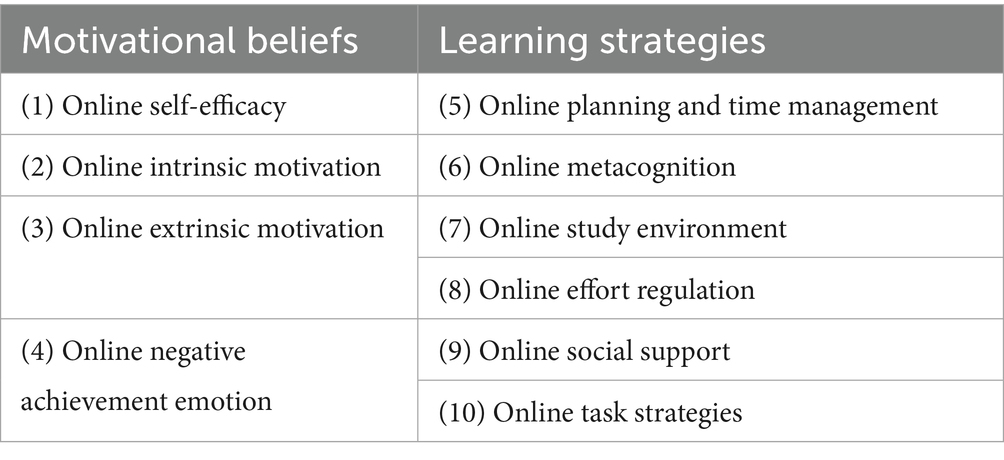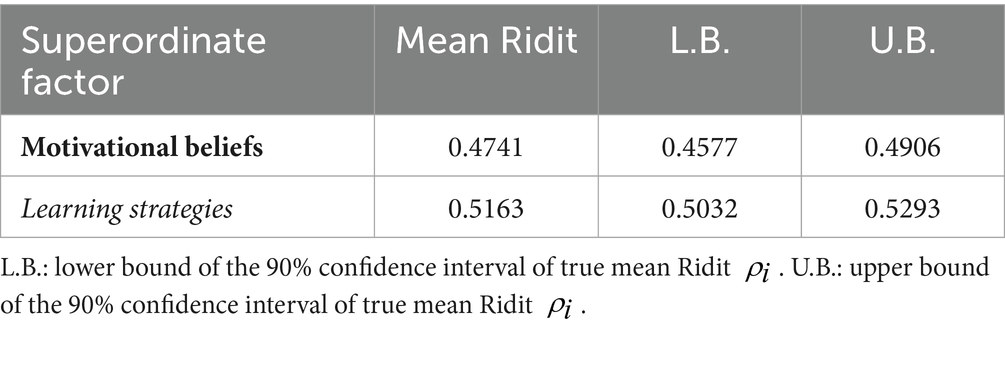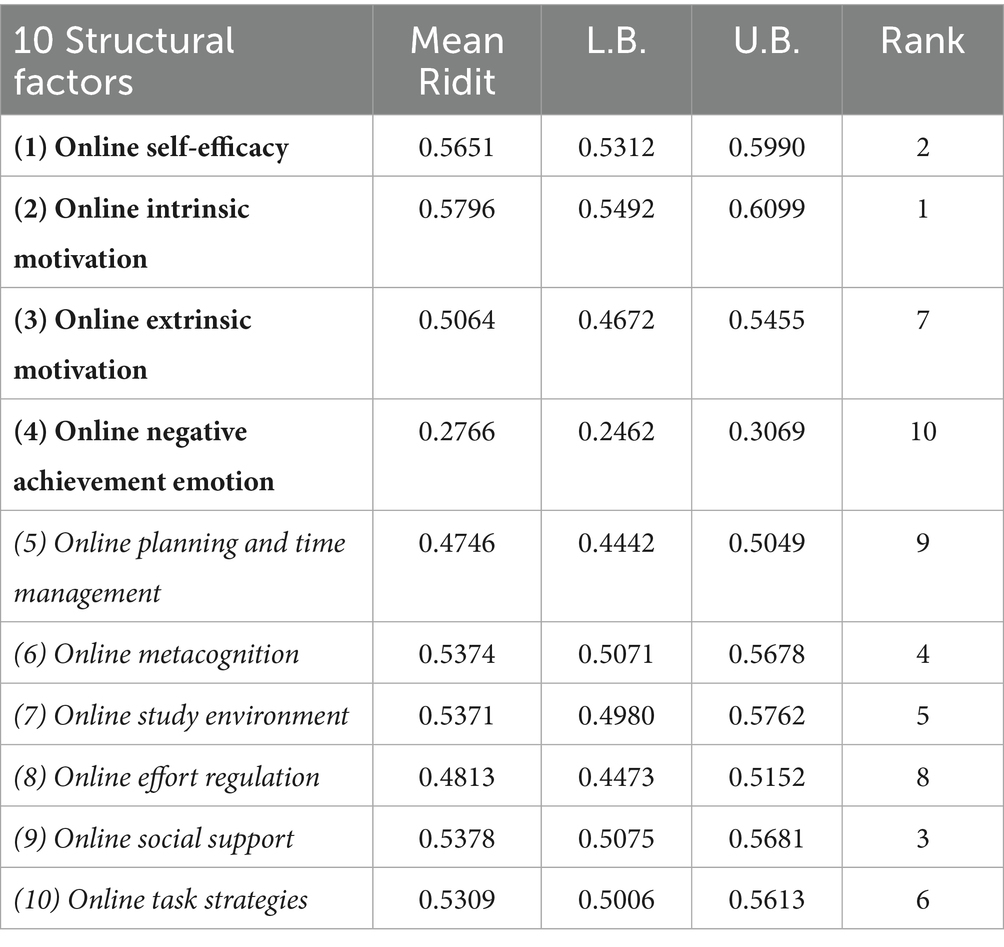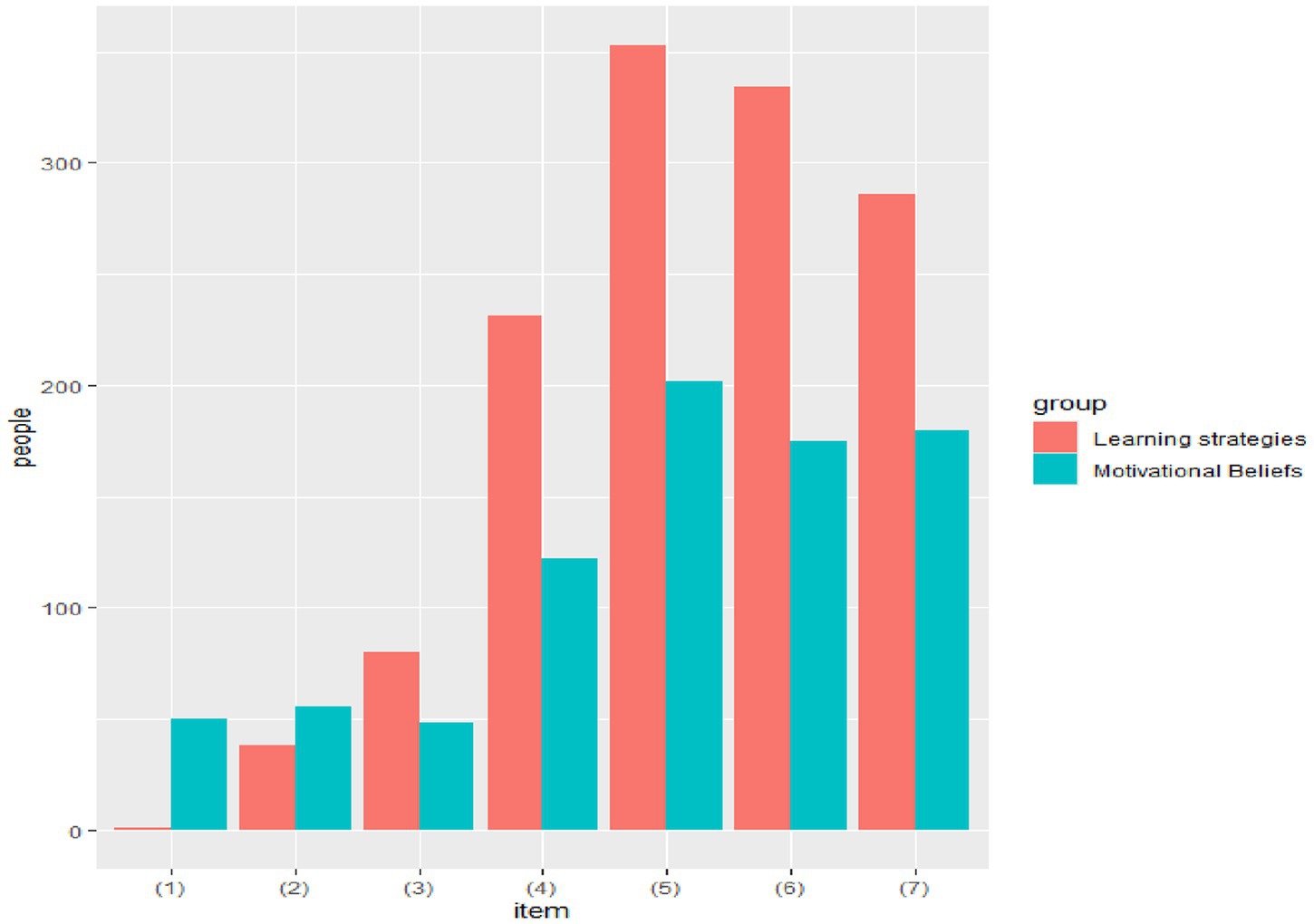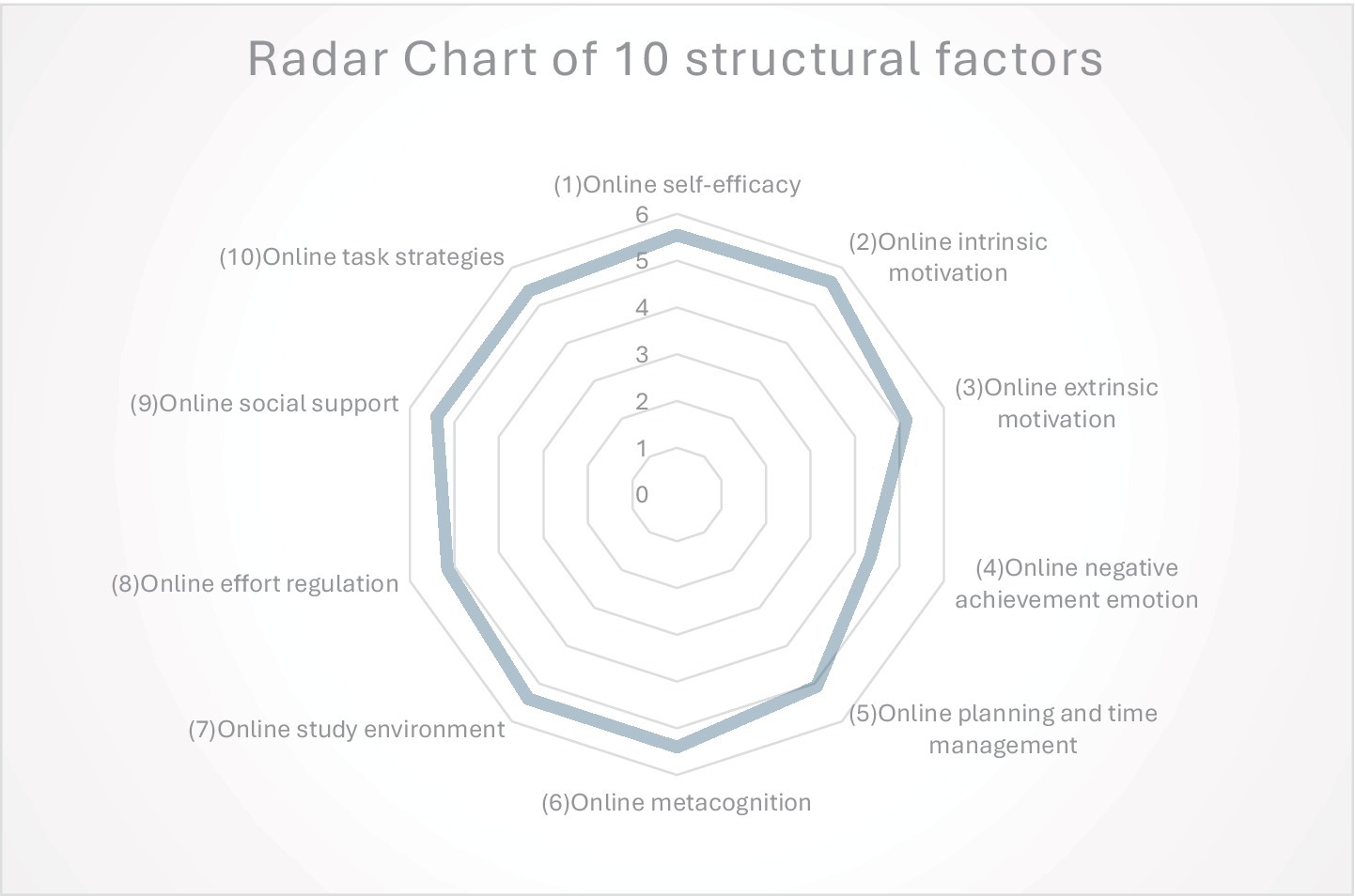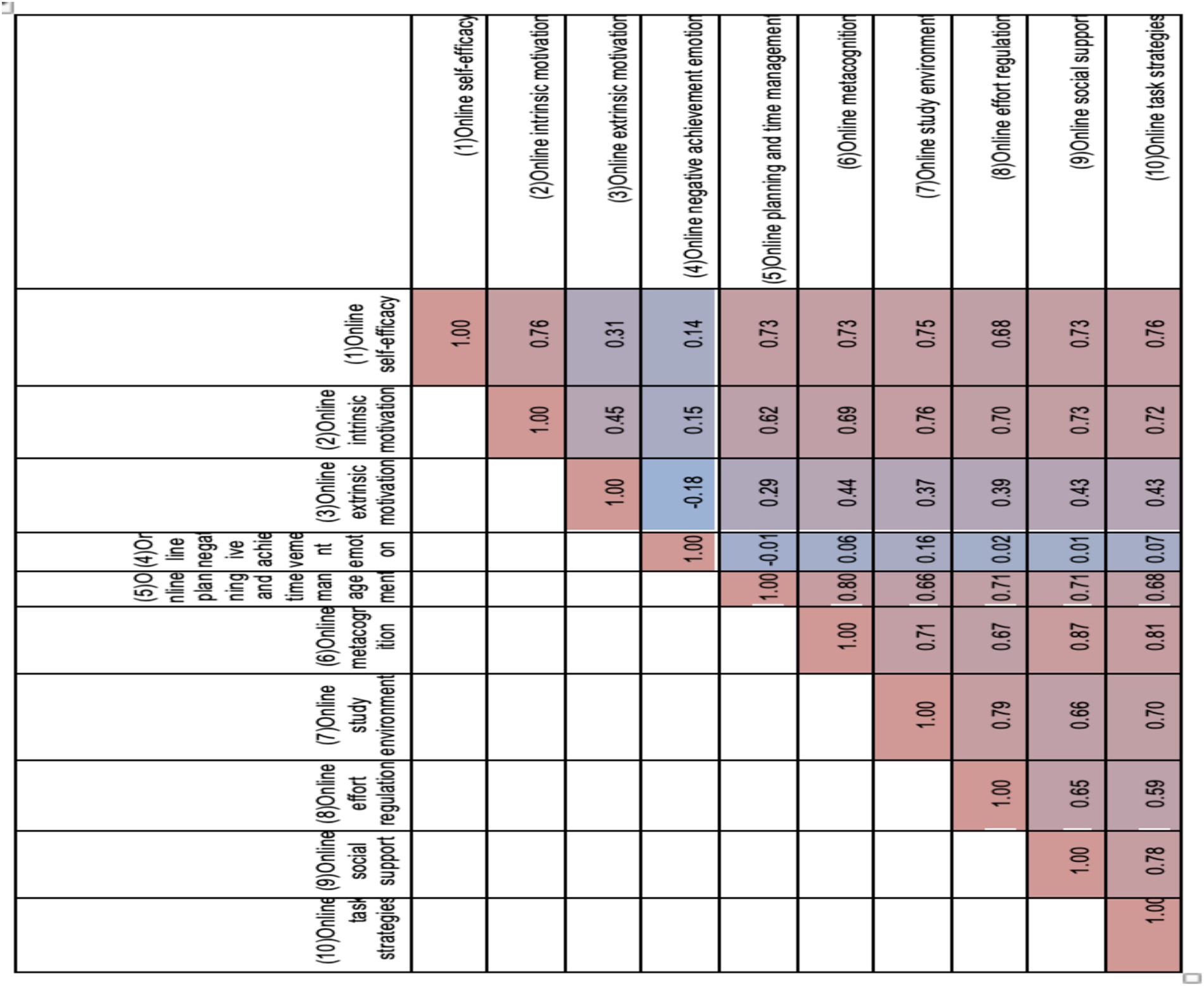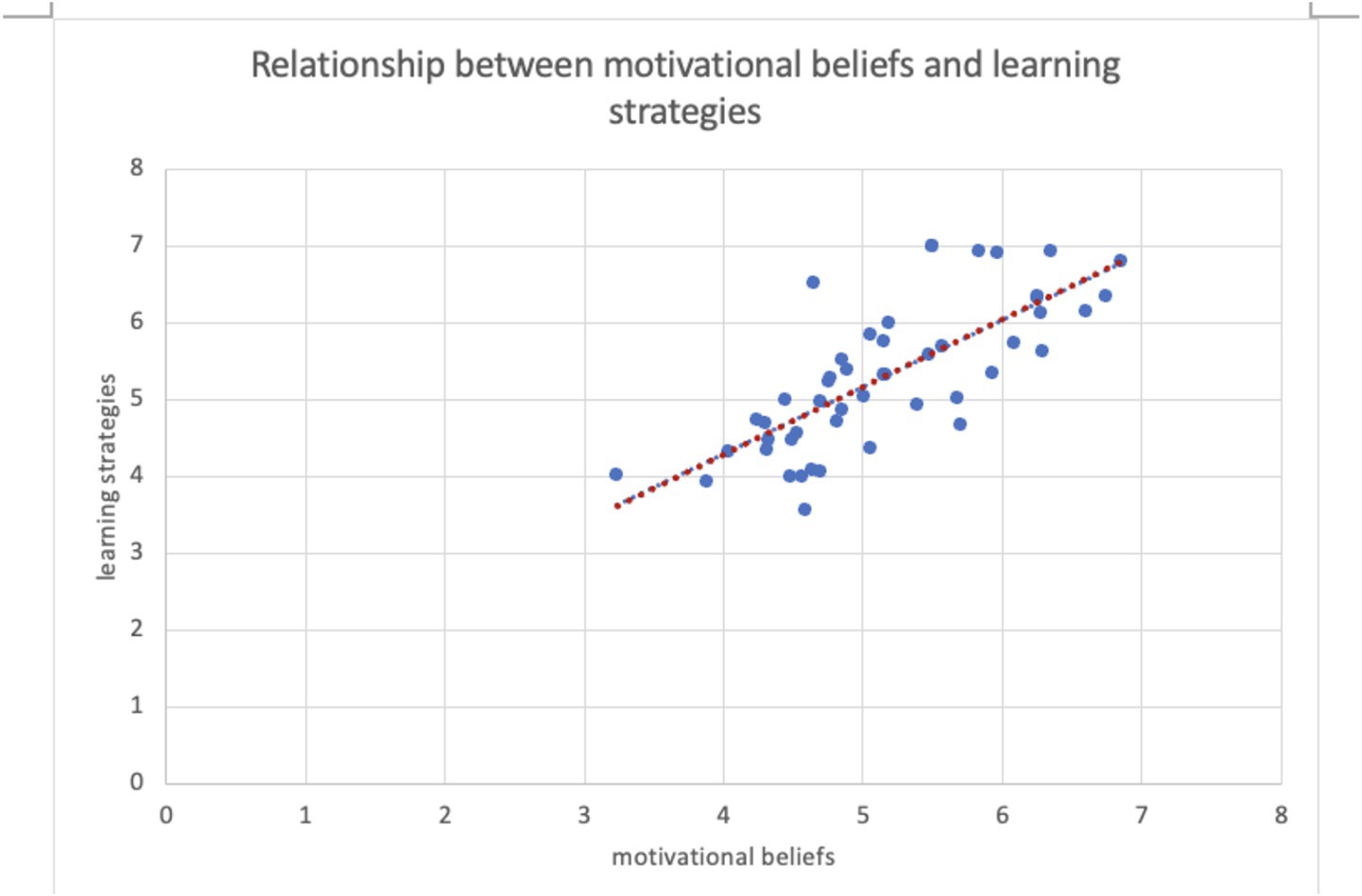- 1School of Mathematics, Guangdong University of Education, Guangzhou, Guangdong, China
- 2Department of Mathematics, The Hong Kong University of Science and Technology, Kowloon, Hong Kong SAR, China
Self-regulated learning (SRL) has emerged as a central concern in educational research, particularly with the growing prevalence of online learning environments. This study applies Ridit analysis to examine the SRL behaviors of 49 graduate students, with a focus on their motivational beliefs and learning strategies in online contexts. The results indicate that online intrinsic motivation was the most positively endorsed dimension, while negative achievement emotions were the least. Overall, students demonstrated high levels of motivation and low levels of emotional resistance toward online learning. These findings suggest that learners generally exhibit adaptive SRL behaviors in response to online learning challenges. The study contributes to the development of more effective online instructional strategies and offers implications for future research on SRL in digital learning environments.
Introduction
Self-regulated learning (SRL) has emerged as a pivotal focus in educational research, particularly with the increasing prevalence of online and hybrid graduate-level courses. In these digitally mediated environments, learners are expected to take greater responsibility for managing their own learning processes, often without real-time instructor guidance. As graduate education becomes more flexible and learner-centered, the ability to self-regulate becomes not only desirable but essential. Online learning settings require students to maintain focus, motivation, and discipline—conditions under which SRL is known to thrive or falter.
SRL involves a cyclical process where learners set goals, monitor their progress, and reflect on their learning strategies and outcomes (Zimmerman, 2002). The ability to self-regulate is crucial for developing lifelong learning skills and achieving academic goals. This is especially important in online learning contexts, where students often need to manage their own learning without immediate guidance from instructors or peers. Online learning environments offer both opportunities and challenges for self-regulated learners. On one hand, they provide flexibility and access to a wide range of resources (Artino, 2008). On the other hand, they require students to possess a high degree of self-discipline and motivation to succeed (Broadbent and Poon, 2015).
Motivational beliefs, such as intrinsic and extrinsic motivation, play a significant role in SRL. Deci and Ryan’s (2000) self-determination theory posits that intrinsic motivation, driven by interest and enjoyment, leads to higher engagement and persistence in learning activities, whereas extrinsic motivation, driven by external rewards or pressures, may not sustain long-term engagement. Effective learning strategies are essential for managing the demands of online learning. Metacognitive strategies, such as planning, monitoring, and evaluating one’s learning processes, are particularly important (Pintrich, 2004). Time management and organizational skills are also crucial for maintaining a structured learning schedule in a flexible online environment (Zimmerman, 2008).
Additionally, social support plays a significant role in fostering a positive online learning experience. Vygotsky’s (1978) theory of social constructivism emphasizes the importance of social interactions in cognitive development. Research by Rovai (2002) demonstrates that online learners who actively seek help from peers and instructors and participate in online discussions tend to have better academic outcomes. However, negative achievement emotions, such as anxiety and helplessness, can significantly hinder learning. Pekrun’s (2006) control-value theory of achievement emotions suggests that these emotions arise from a perceived lack of control over learning tasks and low value attributed to the learning outcomes. These emotions can lead to avoidance behaviors and decreased engagement, impacting overall academic performance.
Despite the extensive research on SRL and online learning, there remains a gap in understanding how graduate students specifically engage in SRL behaviors in online contexts. Moreover, while Likert-scale data are common in SRL research, the application of Ridit analysis—a robust nonparametric technique that does not assume a normal distribution—has been rarely explored in this field. Introduced by Bross (1958), Ridit analysis enables nuanced comparisons of ordinal data by assigning relative importance to response categories. This method is especially suitable for identifying hierarchical patterns in learners’ perceptions and behaviors, making it an ideal fit for studies examining multiple SRL factors simultaneously.
This study aims to explore the self-regulated learning behaviors of graduate students through a detailed Ridit analysis. By applying Ridit analysis to data collected from graduate students, this research seeks to provide nuanced insights into their motivational beliefs and learning strategies within an online learning context. The findings will contribute to the development of more effective online learning strategies by addressing key research questions:
1. What are the self-regulated learning (SRL) behaviors of graduate students in online learning environments, and how do their motivational beliefs and learning strategies influence these behaviors?
2. Which motivational beliefs and learning strategies are most prominent among graduate students in online learning environments
Literature review
Self-regulated learning (SRL) is recognized as a vital component of academic success, enabling students to take control of their learning processes through goal setting, self-monitoring, and self-reflection. Zimmerman (2002) conceptualizes SRL as a cyclical process involving planning, monitoring, and evaluating learning strategies and outcomes. This process is especially important in online environments, where learners must manage their learning independently without the immediate presence of instructors or peers (Broadbent and Poon, 2015).
The shift to online learning presents both opportunities and challenges for self-regulated learners. While online environments offer flexibility and access to diverse resources (Artino, 2008), they also demand high levels of motivation and self-discipline. Learners with strong self-regulation skills tend to achieve better outcomes (Barnard et al., 2008), whereas the lack of face-to-face interaction may lead to isolation and reduced motivation (Kuo et al., 2014). Motivational beliefs, including intrinsic and extrinsic motivation, significantly influence SRL. Deci and Ryan’s (2000) Self-Determination Theory highlights that intrinsic motivation—driven by personal interest and satisfaction—promotes sustained engagement, while extrinsic motivation—based on external rewards—may not yield long-term benefits. Schunk and Zimmerman (2008) further emphasize the critical role of self-efficacy in supporting learners’ persistence and strategy use.
In addition to motivation, cognitive and metacognitive strategies are essential for successful SRL. Metacognitive regulation—planning, monitoring, and evaluating one’s progress—allows learners to adapt strategies to task demands (Pintrich, 2004). Time management and organizational skills are also vital in online learning environments where learners must structure their own schedules (Zimmerman, 2008). Azevedo and Cromley (2004) found that students who effectively employ these strategies are more likely to succeed in digital learning contexts.
In recent years, advances in educational technology have introduced new tools to support SRL. Learning Management Systems (LMS) now commonly include analytics dashboards that track behavioral indicators such as login frequency, time-on-task, and resource access. These dashboards enhance learners’ self-monitoring by offering visualizations of progress and engagement patterns (Kept Matcha et al., 2020; Ifenthaler and Yau, 2020). Moreover, adaptive learning systems provide personalized learning experiences by adjusting content and feedback in response to learner performance. These systems promote goal setting and reflection by supporting learners’ needs in real time (Noroozi et al., 2021; Chen et al., 2022). In parallel, AI-driven engagement tracking tools—such as nudging dashboards and predictive alerts—have shown promise in identifying disengaged learners and delivering timely prompts to improve persistence and completion rates (Sun and Rueda, 2023). Collectively, these technologies serve as external scaffolds, supporting the SRL cycle of planning, monitoring, and reflection.
Social and emotional factors also shape SRL in online learning. Vygotsky’s (1978) social constructivist theory emphasizes the value of social interaction in cognitive development. Learners who actively engage with peers and instructors tend to experience greater satisfaction and academic success (Rovai, 2002; Garrison and Arbaugh, 2007). Conversely, negative achievement emotions such as anxiety or helplessness may undermine learning. Pekrun’s (2006) Control-Value Theory suggests that these emotions emerge when students perceive low control over tasks or low value in learning outcomes. They may lead to avoidance and disengagement. Strategies like cognitive reappraisal and seeking social support are therefore essential for emotional regulation in online settings (Pekrun et al., 2002).
In terms of methodology, Ridit analysis offers a unique, nonparametric approach to analyzing ordinal survey data such as Likert-scale responses. Introduced by Bross (1958), this method transforms categorical responses into relative cumulative probabilities, allowing for rank-based comparisons across groups or items. Unlike traditional parametric methods that assume equal intervals and normal distribution, Ridit analysis preserves the ordinal nature of the data while revealing nuanced differences in response distributions. Despite its advantages, Ridit analysis remains underused in educational research—particularly in SRL studies, where mean-based methods may obscure meaningful differences in learner perceptions (Fahim et al., 2025; Kumar, 2024). In this study, Ridit analysis is adopted to explore how graduate students rank the relative importance or presence of various motivational and strategic learning behaviors. This approach allows for a clearer identification of dominant and underdeveloped SRL components within the target population.
This literature review highlights the multifaceted nature of SRL and the various factors that influence it in online learning environments. By integrating insights from motivational theories, learning strategies, social support mechanisms, and emotional management, this study aims to fill the gap in understanding graduate students’ SRL behaviors and provide a comprehensive analysis through the application of Ridit analysis. The findings will contribute to the development of more effective online learning strategies and interventions tailored to the needs of graduate students.
Methodology
This study employed a quantitative research design to investigate the self-regulated learning (SRL) behaviors of graduate students in an online learning environment. Specifically, it utilized Ridit analysis, a nonparametric statistical method, to examine how students rated various motivational beliefs and learning strategies, based on their responses to a structured Likert-scale questionnaire.
Context and participants
Participants were 49 graduate students enrolled in an education-related master’s program at a research-intensive university in East Asia. Data were collected in the context of a 12-week online course focused on educational psychology and digital pedagogy. The course was delivered fully online in an asynchronous format via the university’s Learning Management System (LMS). Weekly activities included video lectures, assigned readings, participation in online discussion forums, and project-based learning tasks. Students were expected to manage their own learning schedules, engage in peer interaction online, and complete tasks such as collaborative discussions, individual reflections, and multimedia-based assignments. The online questionnaire was administered using the Chinese survey platform Wenjuanxing over a two-week period during the final weeks of the course. Out of 75 students invited, 49 completed the survey in full, yielding a response rate of 65.3%.
Instrument
Data were gathered using a comprehensive questionnaire adapted from Broadbent and Poon’s (2015) and Jaclyn Broadbent’s SRL instrument, tailored for online learning contexts. The questionnaire consisted of items grouped under ten structural SRL factors, categorized into two superordinate domains: motivational beliefs and learning strategies. Each item was rated on a 7-point Likert scale, ranging from 1 (“not at all true of me”) to 7 (“very true of me”). This scale allowed for nuanced interpretation of learner self-perceptions while maintaining comparability with other widely used SRL measures (see Table 1).
Data analysis
In this study, Ridit analysis was employed as a nonparametric method to examine students’ relative agreement with various self-regulated learning (SRL) factors, based on ordinal data collected through Likert-scale questionnaire items. Originally proposed by Bross (1958), Ridit analysis—short for “Relative to an Identified Distribution”—is particularly suitable for data that do not meet parametric assumptions such as normality or equal intervals. It converts categorical responses into cumulative probability values, enabling rank-based comparisons among groups or items.
The procedure began with the construction of a reference distribution. Following Bross’s (1958) recommendation and due to the absence of a predefined reference group, we used the total response frequencies across all items as the reference dataset. A contingency table (see Table 2) was first constructed, comprising m groups (i.e., items) and n ordered categories (i.e., Likert responses), where each cell Nij indicates the frequency of category j for group i. Column-wise marginal frequencies fj, cumulative frequencies Fj, and Ridit scores Rj = Fj/N were then calculated for each response category in the reference dataset.
Next, for each item, Ridit scores were applied to its observed frequencies to compute a weighted average—known as the mean Ridit score (rˉi)—which serves as a summary measure of students’ relative agreement with the corresponding SRL factor. Confidence intervals around each mean Ridit score were estimated using the large-sample normal approximation, and items with confidence intervals entirely above or below the neutral value of 0.5 were interpreted as having significantly higher or lower relative agreement, respectively.
To test for statistically significant differences among the SRL factors, the Kruskal–Wallis test was applied to the mean Ridit scores. When necessary, a correction for small sample sizes was employed to improve the accuracy of the test statistic. This comprehensive procedure—spanning from contingency table construction to hypothesis testing—allowed for a rank-based, distribution-free evaluation of students’ perceptions of SRL components in an online learning context, while preserving the ordinal nature of the data.
Compute RIDIT for the reference data set
a. Select a population to serve as a reference data set. According to Bross, the reference data set should be large enough to insure that the RIDIT will be stable, i.e., generally, a group with a larger sample size than the other groups will be selected as the reference group. When the population cannot be easily identified (that’s exactly the situation in our study), the reference dataset can also be set as the total response of the survey.
b. Compute frequency for the jth ordered category of response, where .
c. Compute mid-point accumulated frequency for each category of responses: , and , .
d. Compute RIDIT value , and is the total number of responses from the Likert scale survey of interest. By definition, the expected value of R for the reference data set is always 0.5.
Compute RIDIT and mean RIDIT for comparison data sets
Note that a comparison data set is comprised of the frequencies for each category of a Likert scale item. Since there are m Likert-scale items in this illustration, there will be m comparison data sets.
a. Compute RIDIT value for each category of scale items
where is the frequency of category for the group, and is a short form for the summation of frequencies for group across all categories, i.e.,
b. Compute mean RIDIT for each Likert-scale item:
c. Compute confidence interval for true mean RIDIT . When the size of the reference data set is very large relative to that of any comparison data set, the confidence interval of any is where is the ( )th quantile of a standard normal distribution.
d. Test the hypothesis by using Kruskal-Wallis statistics
If N is not sufficient large in size, then the correction of Kruskal-Wallis statistics will be used
where . It can be shown that and asymptotically follow a distribution with (m-1) degree of freedom.
Finally, we can have the following conclusions:
1. Since in our study the scale is from “not at all very true of me” to “very true of me,” a high value of is more agreeable than a low value of because a low value of indicates a low probability of disagreeing.
2. The response patterns of scale items with overlapped confidence intervals of are considered, among the respondents, to be statistically indifferent from each other.
Results
We first use Ridit analysis to compare the agreement between the two superordinate factors. Table 3 shows the Ridits calculation for this comparison.
The value of is 11.4201 and p-value is 0.0007266. So, the two superordinate factors are significantly different. Indeed, we can further find that the respondents are a bit more agreeable to learning strategies (mean Ridit = 0.5163) than motivational beliefs (mean Ridit = 0.4741) because their confidence intervals do not overlap with each other, see Table 4.
Table 4 presents the Ridit analysis results for the two superordinate factors. The mean Ridit value for learning strategies was 0.5163 (90% CI: 0.5032–0.5293), significantly exceeding the reference value of 0.5, indicating a positive tendency within the measured dimension. In contrast, Motivational Beliefsyielded a mean Ridit of 0.4741 (90% CI: 0.4577–0.4906), with its confidence interval entirely below 0.5, suggesting comparatively weaker performance. The non-overlapping confidence intervals between the two factors reinforce the statistical significance of their difference (α = 0.10).
Similar study is used for the 10 structural factors.
Table 5 presents the Ridit analysis and ranking of 10 structural factors. Online Intrinsic Motivation ranked highest with a mean Ridit of 0.5796 (90% CI: 0.5492–0.6099), significantly exceeding the reference value of 0.5, indicating its dominant positive association with student outcomes. Online Self-efficacy (Ridit = 0.5651) and Online Social Support (Ridit = 0.5378) secured the second and third positions, respectively, with confidence intervals entirely above 0.5, reinforcing their robust facilitative roles. Conversely, Online Negative Achievement Emotion exhibited the lowest Ridit value (0.2766; 90% CI: 0.2462–0.3069), with its interval entirely below 0.5, suggesting a pronounced inhibitory effect. Self-regulatory factors such as Online Planning and Time Management (Ridit = 0.4746) and Online Effort Regulation (Ridit = 0.4813) demonstrated comparatively weaker impacts, potentially reflecting systemic challenges in autonomous learning management within online environments.
According to the mean Ridit scores of these factors, we can also rank them in the following order (from the highest degree of agreement to the lowest):
(2) Online intrinsic motivation > (1) Online self-efficacy > (9) Online social support > (6) Online metacognition > (7) Online study environment > (10) Online task strategies > (3) Online extrinsic motivation > (8) Online effort regulation > (5) Online planning and time management > (4) Online negative achievement emotion
Remark that for (4) Online negative achievement emotion, agreement indicates a high level of negative achievement emotion, while disagreement indicates a high level of positive achievement emotion.
The Ridit analysis revealed a clear hierarchy among structural factors influencing online learning outcomes. Online intrinsic motivation (mean Ridit = 0.5796, rank 1), self-efficacy (0.5651, rank 2), and social support (0.5378, rank 3) emerged as the strongest facilitators, with 90% confidence intervals fully above the neutral threshold (0.5), indicating robust positive associations. Conversely, online negative achievement emotion (0.2766, rank 10) demonstrated a pronounced negative impact, its confidence interval (0.2462–0.3069) entirely subthreshold. Self-regulatory strategies—effort regulation (0.4813, rank 8) and planning/time management (0.4746, rank 9)—performed weakest among adaptive factors, highlighting systemic challenges in autonomous learning. These findings underscore the need to prioritize intrinsic motivation enhancement and emotional support while re-evaluating interventions for self-regulation in online education.
Conclusion
RQ1: What are the self-regulated learning (SRL) behaviors of graduate students in online learning environments, and how do their motivational beliefs and learning strategies influence these behaviors?
Comparison of learning strategies and motivational beliefs
The bar chart compares the number of students endorsing various items related to Learning Strategies and Motivational Beliefs. It shows how these two key elements of SRL differ in terms of student endorsement. Learning Strategies (represented in red) are generally more strongly endorsed than Motivational Beliefs (represented in teal), particularly in items (5–7), which have the highest endorsement values. This suggests that, within the context of online learning, graduate students are more likely to focus on strategies to regulate their learning behavior, such as time management and self-monitoring, than on motivational beliefs such as intrinsic motivation or achievement emotions (Figure 1).
The radar chart visualizes the 10 structural factors that influence online learning behaviors, providing a broader understanding of the factors that contribute to SRL. These factors include online self-efficacy, intrinsic and extrinsic motivation, and planning and time management. The chart shows how graduate students rate each factor, with higher values indicating stronger beliefs or behaviors in these areas. For instance, online self-efficacy and intrinsic motivationare ranked higher, suggesting that students’ confidence in their ability to succeed and their intrinsic drive to learn play a significant role in their SRL behaviors. In contrast, online negative achievement emotions and online social support are rated lower, indicating that students may not perceive these factors as strongly influencing their self-regulated learning behaviors (see Figure 2).
Measurement instrument refinement
To enhance psychometric robustness, the original 5-item Online Negative Achievement Emotion (ONAE) subscale was reconfigured using reverse-coded items (Items 6–10) through dual-negative phrasing. This adaptation aligns with the unified scoring protocol where lower values (1 = “strongly disagree”) indicate healthier emotional states across all Self-Regulated Learning (SRL) constructs. Post-hoc reliability analysis revealed improved internal consistency (Cronbach’s α increased from 0.78 to 0.85), while confirmatory factor analysis demonstrated stronger factor loadings for inverted items (λ = 0.72–0.81 vs. original λ = 0.63–0.69), validating the psychometric superiority of this bidirectional scaling approach in capturing nuanced emotional regulation dynamics in digital learning environments. The correlation matrix reveals key insights into the self-regulated learning (SRL) behaviors of graduate students in online learning environments. Notably, intrinsic motivation and self-efficacy are strongly correlated (0.76), suggesting that students who are intrinsically motivated are more likely to have higher confidence in their learning abilities. The study also shows a strong relationship between the online study environment and effort regulation (0.75), highlighting the importance of a supportive learning environment in promoting better self-regulation. Moreover, online extrinsic motivation and task strategies exhibit a moderate positive correlation (0.45), indicating that external motivation can also encourage students to adopt structured learning approaches. Additionally, online metacognition is positively correlated with effort regulation (0.67), suggesting that students who engage in metacognitive practices are better at managing their learning efforts. However, online negative achievement emotions show weaker or even negative correlations with other factors, such as extrinsic motivation and planning (−0.18), pointing to the need for addressing these emotions in interventions. Overall, the findings underscore the importance of fostering intrinsic motivation, providing a supportive online study environment, and teaching metacognitive strategies to enhance SRL behaviors and improve learning outcomes in online settings (see Figure 3).
The scatter plot above shows the relationship between motivational beliefs and learning strategies. The data points are represented by blue dots, and the red dotted line represents the fitted regression line. From the plot, there is a positive linear relationship between the two variables, suggesting that higher motivational beliefs tend to correlate with higher use of learning strategies. The p-value is 8.04E-10, which indicates a highly significant relationship between motivational beliefs and learning strategies. This suggests that motivational beliefs have a significant effect on how students approach and apply their learning strategies in an online environment. The R-squared value (R2 = 0.5557) indicates that the model explains approximately 55.57% of the variance in learning strategies based on motivational beliefs (see Figure 4). While this is a moderate level of explanation, it also suggests that other factors beyond motivational beliefs contribute to students’ use of learning strategies, which should be explored in further studies. In summary, the analysis shows that while motivational beliefs significantly impact learning strategies, additional factors are likely influencing the overall behavior of students. Further research could help identify these other contributing factors.
RQ2: Which motivational beliefs and learning strategies are most prominent among graduate students in online learning environments?
In this section, we explore the most prominent motivational beliefs and learning strategies among graduate students in online learning environments. The analysis is based on scatter plots and regression analysis, which show the relationship between these two factors. First, Ridit analysis was conducted to compare the agreement between the two superordinate factors: motivational beliefs and learning strategies. Table 3 presents the Ridits calculation for this comparison, where each superordinate factor is divided into categories from “not at all very true of me” to “very true of me.” The results show that respondents are generally more agreeable to learning strategies (mean Ridit = 0.5163) compared to motivational beliefs (mean Ridit = 0.4741). The confidence intervals for these two factors do not overlap, confirming this difference. The regression analysis of the scatter plot further emphasizes this relationship. The positive linear correlation observed between motivational beliefs and learning strategies supports the idea that as students’ motivation increases, they are more likely to engage in self-regulated learning strategies. This relationship is statistically significant, as indicated by a p-value of 0.0007266, which confirms that the two factors are significantly different. Additionally, the analysis shows that the mean Ridit for learning strategies is higher than that for motivational beliefs, suggesting that, overall, graduate students in online environments tend to focus more on applying learning strategies to regulate their learning behaviors. This difference suggests that learning strategies might be more actively utilized or perceived as more essential compared to motivational factors in shaping students’ behaviors.
In conclusion, the findings indicate that learning strategies are slightly more prominent than motivational beliefs among graduate students in online learning environments, with a significant difference in agreement. The regression analysis further supports this by demonstrating a positive relationship between the two factors, which highlights the importance of fostering both motivational beliefs and learning strategies to improve self-regulation and academic success in online learning settings. In our study, we analyzed the agreeability and disagreeability of self-reported measures of SRL, focusing on motivational beliefs and learning strategies using Ridit analysis. The findings revealed that “Online intrinsic motivation” was the most significantly agreeable item, while “Online negative achievement emotion” was the most significantly disagreeable item. Specifically, respondents most agreed with the statement “I get a sense of achievement when I learn new skills or information” for intrinsic motivation. Conversely, for negative achievement emotion, respondents agreed most with “While studying, I want to distract myself to lower my anxiety level” and disagreed most with “When I have to study online, I start to feel bad.” These results indicate that graduate students exhibit positive behaviors when encountering challenges in online learning, showing a strong sense of intrinsic motivation and resilience against negative emotions. The analysis provides valuable insights into the factors that influence SRL in online contexts, suggesting that fostering intrinsic motivation and addressing negative emotions are critical for enhancing online learning experiences.
Based on these findings, several actionable implications emerge. Course designers should consider integrating pedagogical strategies that promote intrinsic motivation—such as problem-based learning, authentic tasks, and learner autonomy—to strengthen student engagement. Additionally, institutions may implement structured support such as anxiety-management workshops to address students’ negative achievement emotions. These recommendations directly align with the identified SRL priorities and offer practical avenues to enhance motivation, emotional regulation, and self-regulated learning in digital environments.
The comprehensive understanding gained from this study contributes to the development of more effective online learning strategies and interventions. By identifying the key motivational beliefs and learning strategies that influence SRL, educators and researchers can design targeted support mechanisms to improve the online learning experience for graduate students. Furthermore, this study offers a new direction for research on self-reported measures of SRL, emphasizing the importance of detailed statistical analyses like Ridit to uncover nuanced insights into student behaviors and preferences.
Discussion
The findings of this study provide significant insights into the self-regulated learning (SRL) behaviors of graduate students in an online learning environment. The application of Ridit analysis has allowed for a nuanced understanding of students’ motivational beliefs and learning strategies, revealing key areas of agreement and disagreement.
Motivational beliefs
The analysis highlighted “Online intrinsic motivation” as the most significantly agreeable factor. This underscores the importance of intrinsic motivation in driving student engagement and success in online learning environments. The high agreement with the statement “I get a sense of achievement when I learn new skills or information” suggests that students are motivated by the internal satisfaction they derive from learning. This aligns with Deci and Ryan's (2000) Self-Determination Theory, which posits that intrinsic motivation, driven by interest and enjoyment, leads to higher engagement and persistence in learning activities.
Conversely, “Online negative achievement emotion” was identified as the most significantly disagreeable factor. This finding indicates that negative emotions, such as anxiety and helplessness, are less prevalent among the respondents. The disagreement with the statement “When I have to study online, I start to feel bad” further supports this observation. However, the agreement with “While studying, I want to distract myself to lower my anxiety level” suggests that some students do experience anxiety but manage it by seeking distractions. This highlights the need for strategies to help students cope with anxiety and stay focused on their studies.
Learning strategies
The analysis of learning strategies revealed no significantly agreeable items, suggesting a balanced perception of these strategies among students. However, “Online social support” was ranked relatively high, indicating that students value the support they receive from peers and instructors in an online environment. This finding is consistent with Vygotsky’s (1978) theory of social constructivism, which emphasizes the importance of social interactions in cognitive development. The use of online forums, discussion boards, and social media to seek help and clarify information underscores the importance of creating supportive online learning communities.
“Online planning and time management” and “Online effort regulation” were identified as significantly disagreeable factors. This suggests that students may struggle with effectively managing their time and effort in an online learning context. These findings align with previous research by Broadbent and Poon (2015), which highlighted the challenges students face in self-regulating their learning in online environments. Addressing these challenges through targeted interventions, such as time management workshops and structured study schedules, could enhance students’ SRL behaviors.
Implications for practice
The insights gained from this study have several practical implications for educators and instructional designers. First, fostering intrinsic motivation should be a priority in the design of online courses. This can be achieved by incorporating elements that make learning enjoyable and personally rewarding, such as interactive content, gamification, and opportunities for self-directed learning.
Second, providing robust social support mechanisms is crucial for student success in online learning. Instructors should actively facilitate online discussions and create a sense of community among students. Peer support networks and mentorship programs can also be beneficial in helping students navigate the challenges of online learning.
Third, addressing the issues related to planning and time management is essential. Educators can offer resources and training on effective time management techniques and encourage students to set realistic goals and break larger tasks into smaller, manageable steps. Additionally, integrating regular feedback and self-assessment opportunities can help students monitor their progress and adjust their strategies accordingly.
The potential role of generative AI in supporting SRL
Recent developments in generative AI technologies—such as AI-powered writing assistants (e.g., ChatGPT, Grammarly)—have introduced new possibilities for enhancing learners’ metacognitive strategies and self-regulation in online learning environments. These tools can assist students in goal setting, task planning, idea generation, and real-time reflection, which are all essential components of self-regulated learning (SRL). From a motivational perspective, the integration of generative AI may bolster intrinsic motivation by reducing cognitive barriers and providing immediate, personalized feedback. For example, students may feel a stronger sense of competence when they use AI to scaffold difficult writing tasks, potentially enhancing their self-efficacy. This aligns with Zimmerman’s (2000) framework, where perceived competence and feedback loops are critical to sustained self-regulation. Moreover, AI tools can support metacognitive monitoring by helping learners identify gaps in understanding and revise their work iteratively. However, it is also important to critically consider the potential for over-reliance on AI, which could inadvertently undermine students’ development of independent learning strategies if not carefully scaffolded. Future research may explore how the design and use of AI-powered tools influence SRL behaviors across diverse educational settings. Educators and designers should consider how to integrate AI responsibly, promoting learner autonomy while leveraging the affordances of such technologies to support motivational and cognitive processes in online learning.
Future research and limitations
While this study offers valuable insights into graduate students’ self-regulated learning (SRL) in online environments, several limitations should be acknowledged. The relatively small sample size (n = 49) constrains the generalizability of the findings, despite Ridit analysis being appropriate for small-scale ordinal data. Future research should involve larger, more diverse populations to enhance external validity. Moreover, this study did not address the role of generative artificial intelligence (AI) tools, which are increasingly embedded in digital learning environments. As technologies such as AI-based writing assistants and recommendation systems gain traction, it is important to examine their influence on learners’ metacognitive strategies, intrinsic motivation, and self-efficacy. Future studies could compare SRL outcomes between students who use AI tools and those who do not. In addition, longitudinal designs are needed to investigate how SRL behaviors develop over time and how adaptive instructional interventions—such as feedback informed by learning analytics—can support sustained improvement in online learners’ motivation, self-regulation, and academic achievement.
Data availability statement
The datasets presented in this article are not publicly available but are available from the corresponding author on reasonable request. Requests to access the datasets should be directed to c29waGlleGlhb3l1eHVAMTYzLmNvbQ==.
Ethics statement
The studies involve human participants. Research methods and procedures for this study were conducted in accordance with human subjects’ guidelines and approved by the corresponding author’s Human Research Ethics Committee for research involving human subjects (ref. no. 2022-23-0193). Informed consent was secured from each participant. The studies were conducted in accordance with the local legislation and institutional requirements. The participants provided their written informed consent to participate in this study.
Author contributions
XX: Conceptualization, Data curation, Investigation, Writing – original draft, Writing – review & editing. C-WY: Data curation, Investigation, Software, Writing – review & editing.
Funding
The author(s) declare that no financial support was received for the research and/or publication of this article.
Conflict of interest
The authors declare that the research was conducted in the absence of any commercial or financial relationships that could be construed as a potential conflict of interest.
Generative AI statement
The author(s) declare that no Gen AI was used in the creation of this manuscript.
Publisher’s note
All claims expressed in this article are solely those of the authors and do not necessarily represent those of their affiliated organizations, or those of the publisher, the editors and the reviewers. Any product that may be evaluated in this article, or claim that may be made by its manufacturer, is not guaranteed or endorsed by the publisher.
Supplementary material
The Supplementary material for this article can be found online at: https://www.frontiersin.org/articles/10.3389/feduc.2025.1609448/full#supplementary-material
References
Artino, A. R. (2008). Motivational beliefs and perceptions of instructional quality: predicting satisfaction with online training. J. Comput. Assist. Learn. 24, 260–270. doi: 10.1111/j.1365-2729.2007.00258.x
Azevedo, R., and Cromley, J. G. (2004). Does training on self-regulated learning facilitate students' learning with hypermedia? J. Educ. Psychol. 96, 523–535. doi: 10.1037/0022-0663.96.3.523
Barnard, L., Paton, V. O., and Lan, W. Y. (2008). Online self-regulatory learning behaviors as a mediator in the relationship between online course perceptions with achievement. Int. Rev. Res. Open Distance Learn. 9, 1–11. doi: 10.19173/irrodl.v9i2.516
Broadbent, J., and Poon, W. L. (2015). Self-regulated learning strategies & academic achievement in online higher education learning environments: a systematic review. Internet High. Educ. 27, 1–13. doi: 10.1016/j.iheduc.2015.04.007
Chen, J. (2022). The effectiveness of self-regulated learning (SRL) interventions on L2 learning achievement, strategy employment and self-efficacy: a meta-analytic study. Front. Psychol. 13:1021101. doi: 10.3389/fpsyg.2022.1021101
Deci, E. L., and Ryan, R. M. (2000). The 'what' and 'why' of goal pursuits: human needs and the self-determination of behavior. Psychol. Inq. 11, 227–268. doi: 10.1207/S15327965PLI1104_01
Fahim, A. U., Minami, M., Yang, D., and Kawashita, T. (2025). Analysis of metro users’ perception towards attributes related to bicycle–metro integration: RIDIT and TOPSIS model approach. Sci, 7:13. doi: 10.3390/sci7010013
Garrison, D. R., and Arbaugh, J. B. (2007). Researching the community of inquiry framework: review, issues, and future directions. Internet High. Educ. 10, 157–172. doi: 10.1016/j.iheduc.2007.04.001
Ifenthaler, D., and Yau, J. Y.-K. (2020). Utilizing learning analytics to support study success in higher education: a systematic review. Educational Technology Research and Development, 68, 1977–2002. doi: 10.1007/s11423-020-09788-z
Kumar, U. (2024). Effective inclusive education indicators’ priority list using RIDIT analysis for mainstream primary school inclusion. Cogent Education, 11:2380143. doi: 10.1080/2331186X.2024.2380143
Kuo, Y.-C., Walker, A. E., Schroder, K. E. E., and Belland, B. R. (2014). Interaction, internet self-efficacy, and self-regulated learning as predictors of student satisfaction in online education courses. Internet High. Educ. 20, 35–50. doi: 10.1016/j.iheduc.2013.10.001
Matcha, W., Uzir, N. A., Gašević, D., and Pardo, A. (2020). A systematic review of empirical studies on learning analytics dashboards: A self-regulated learning perspective. IEEE Transactions on Learning Technologies. 13, 226–245. doi: 10.1109/TLT.2019.2916802
Noroozi, O., Biemans, H. J. A., and Mulder, M. (2021). Designing for self-regulated learning: a review of adaptive learning systems. Educ. Technol. Res. Dev. 69, 123–148.
Pekrun, R. (2006). The control-value theory of achievement emotions: assumptions, corollaries, and implications for educational research and practice. Educ. Psychol. Rev. 18, 315–341. doi: 10.1007/s10648-006-9029-9
Pekrun, R., Goetz, T., Titz, W., and Perry, R. P. (2002). Academic emotions in students' self-regulated learning and achievement: a program of qualitative and quantitative research. Educ. Psychol. 37, 91–105. doi: 10.1207/S15326985EP3702_4
Pintrich, P. R. (2004). A conceptual framework for assessing motivation and self-regulated learning in college students. Educ. Psychol. Rev. 16, 385–407. doi: 10.1007/s10648-004-0006-x
Rovai, A. P. (2002). Sense of community, perceived cognitive learning, and persistence in asynchronous learning networks. Internet High. Educ. 5, 319–332. doi: 10.1016/S1096-7516(02)00130-6
Schunk, D. H., and Zimmerman, B. J. (2008). Motivation and Self-regulated Learning: Theory, Research, and Applications. Lawrence Erlbaum Associates.
Sun, J. C. Y., and Rueda, R. (2023). Real-time engagement tracking and nudging: supporting SRL through data-driven dashboards. Br. J. Educ. Technol. 54, 375–392.
Vygotsky, L. S. (1978). Mind in Society: The Development of Higher Psychological Processes. Harvard University Press.
Zimmerman, B. J. (2000). Self-efficacy: an essential motive to learn. Contemporary Educational Psychology, 25, 82–91. doi: 10.1006/ceps.1999.1016
Zimmerman, B. J. (2002). Becoming a self-regulated learner: an overview. Theory Pract., 41, 64–70. doi: 10.1207/s15430421tip4102_2
Keywords: self-regulated learning, Ridit analysis, graduate students learning, mathematics learning achievement, mathematics learning
Citation: Xu X and Yu C-W (2025) Understanding self-regulated learning through Ridit analysis: an in-depth study of graduate students’ perceptions. Front. Educ. 10:1609448. doi: 10.3389/feduc.2025.1609448
Edited by:
Ana Daniela Silva, University of Minho, PortugalReviewed by:
Y. P. Tsang, Hong Kong Polytechnic University, Hong Kong SAR, ChinaNoble Lo, Lancaster University, United Kingdom
Copyright © 2025 Xu and Yu. This is an open-access article distributed under the terms of the Creative Commons Attribution License (CC BY). The use, distribution or reproduction in other forums is permitted, provided the original author(s) and the copyright owner(s) are credited and that the original publication in this journal is cited, in accordance with accepted academic practice. No use, distribution or reproduction is permitted which does not comply with these terms.
*Correspondence: Xiaoyu Xu, c29waGlleGlhb3l1eHVAMTYzLmNvbQ==
 Xiaoyu Xu
Xiaoyu Xu Chi-Wai Yu2
Chi-Wai Yu2